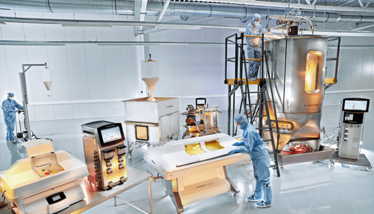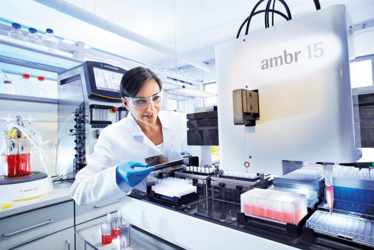Bioprocess Knowledge Is Power
Outsourcing can be an effective way to access in-depth bioprocessing expertise, but leaning on external resources can restrict internal learning. Is there a way to get the best of both worlds?

Developing the most efficient and effective bioprocess possible can increase competitiveness by raising facility productivity and reducing the cost of goods of biologic drugs. Unfortunately, that’s easier said than done. Truly understanding and optimizing a bioprocess requires significant technical competencies. Developing these competencies in house can be expensive, and is typically only an option for highly resourced (and financed) biomanufacturers. An alternative is to outsource production and to take advantage of a contract manufacturer’s technical skills. Outsourcing in this way can, however, restrict the development of in-house capabilities and lead to a reliance on the external manufacturing partner, which is not ideal in the eyes of all companies.
War for talent
Not too long ago, developing biopharmaceutical manufacturing processes was principally about the speed with which processes could be developed, so that novel biologics could enter the clinic as quickly as possible. The importance of speed-to-clinic has not diminished, but companies today also realize the benefits of a well-developed and highly optimized process that is as efficient as possible without compromising product quality. More efficient bioprocesses can deliver lower cost of goods, which is crucial given the increasingly competitive landscape that the industry is operating in. More biosimilars are reaching the market and stealing market share because they are significantly cheaper to develop than an innovator product and can thus be sold at a lower price. Companies with innovator drugs can limit the impact of competition from low-priced biosimilars by minimizing their own production costs.
One of the main ways to improve the efficiency of a bioprocess is to implement new technologies, such as process analytical technologies that are able to improve bioprocessing performance. But implementing new technology is never easy. The field of biopharma manufacturing is seeing an increasing number of new, sophisticated tools and techniques, but the number of engineers with skills and knowledge of these is limited. In fact, it is fair to say that bioprocess companies are now engaged in a ‘war for talent’ due to the rapid expansion of the industry and reliance on employees with science and engineering skills. Industry surveys have highlighted the difficulties that managers have experienced in filling job vacancies (1). Indeed, this problem was discussed in the June issue of The Medicine Maker (2). This problem is likely to persist for some time, particularly as there also seems to be a lack of students studying science and engineering programs at schools and universities.
Large biopharma companies with strong pipelines of biological drugs are more likely to have the resources available in house to assemble large, cross-functional teams that can apply advanced development and production techniques. But what about smaller companies? Such companies are unlikely to have the funds to invest in their own capabilities, but nevertheless, it has been noted that many of today’s new drugs are developed by those small companies (3).
Insourcing versus outsourcing
As mentioned earlier, by outsourcing one can access bioprocess talent without investing in-house. Contract development and manufacturing organizations (CDMOs) are often used by small firms to reach the clinic quickly, as CDMOs usually have existing manufacturing assets (4). CDMOs have to invest in process research to remain competitive and are often quick to implement new processing technologies. Given that CDMOs work with many clients, they also tend to have a wide variety of experience with new technologies, different types of projects, and optimizing bioprocesses.
But outsourcing also has its drawbacks. Bioprocessing competencies that are provided by contract manufacturers may never be internalized in-house. Indeed, when responsibility for process innovation is passed to a CDMO, there is a danger that outsourcing becomes essential rather than a choice (5). Biopharmaceutical companies that become increasingly dependent on CDMO partners are certainly in a tough position when it comes to negotiating commercial terms.
In some instances, managers make the strategic decision to commit to contract manufacturing services, with the intent of never bringing them back in-house. This can work very well, but for others companies there is real value in retaining an option to perform these activities in-house at some point in the future.
It is possible to compromise between in-house development and outsourcing by in-sourcing expertise and process knowledge, while performing process development activities in house. The idea is that the third party will be able to advise on the development of the bioprocess, as well as its scale up, implementation and any regulatory issues. One of the significant benefits of this type of collaboration is that the knowledge can be assimilated to enhance in-house biomanufacturing competencies. A variety of developmental activities can benefit from this approach: for example, process modeling, cell line development, cell bank creation/testing, assay development, high-throughput upstream/downstream process development and process analytical technologies. It really depends on the company and their chosen partner.
Keys to collaboration
In any insourcing collaboration, it’s commonly known that a strategic and proactive approach is essential to get the best benefit. In reality though, a more ad hoc approach is usually applied. Here, we offer a few words of advice.
The ideal time for managers to develop their plans for collaboration is at the beginning of early stage drug development. A gap analysis should be used to identify the knowledge that is required, but not currently available in-house. When it comes to selecting an insourcing partner, we recommend not only looking at their expertise, but also their ability to work across all the necessary geographical locations. Once the partner has been chosen, expectations, project objectives, deliverables, milestones and timelines should be defined. It’s also important to remember that although using external experts means that you won’t have to recruit additional full time employees, you will need to allocate internal resources to manage the relationship.

Leveraging External Expertise
Enzene Biosciences, a subsidiary of Alkem Laboratories, based in India, is developing a product portfolio of both biosimilars and innovator molecules, which it intends to market both in developing countries and developed countries, including the US. Here, Nick Hutchinson, speaks with Himanshu Gadgil, Chief Scientific Officer of Enzene Biosciences.
Why did Enzene Biosciences decided to build a manufacturing facility rather than outsource production?
Enzene Biosciences works with CMOs for the production of clinical trials lots. However, we will have our own production capacity here in India. We are planning to have our facility in place for commercial manufacturing of our first product – and we will have both microbial and mammalian cell production capabilities.
It is important for Enzene Biosciences to develop its own capacity. We believe that the volume requirements of the markets we are entering are likely to be unpredictable, so having our own capacity will give us greater flexibility in managing the supply chain and allow us to quickly respond to changes in demand. A key project milestone will be obtaining US FDA approval for the facility and we wanted to ensure that we are in full control of achieving this objective.
We have successfully developed a continuous platform process for our product portfolio. It is not so easy to find CMOs with these capabilities and the costs are typically high due to the extended facility time needed to run continuous processes. Furthermore, due to the adoption of single-use technology and lower manufacturing footprint for continuous processes, the capital costs associated with building new facilities are significantly reduced, which means there is less need to outsource manufacturing to third parties.
How does working with external process experts from technology providers support your company’s mission?
Our ability to implement new bioprocessing technologies will be a source of competitive advantage. We want to know what is available now and what will be available in the future. We leverage the expertise of process experts to accelerate the adoption of the latest bioprocessing tools – thereby giving us an edge over our competitors worldwide.
How do you ensure Enzene Biosciences is able to internalize the knowledge acquired from collaborations with external process experts?
We have a team of highly qualified scientist and engineers. However, the bioprocess field is evolving rapidly so the expertise of our internal team must develop continuously. Some competency gaps can be filled by external hires, but we also rely on technology providers with a global reach to train a group of our staff members in emerging technologies. We typically require that the number of people receiving such training exceeds our day-to-day needs, giving us redundancy and avoiding over-reliance on a given individual. Once the initial group has received training, we typically task them with disseminating their new knowledge by training a network of their colleagues.
Do you have advice for companies seeking to expand their in-house capacity?
Don’t be bound by existing industry conventions in biologics manufacturing. Markets are becoming increasingly competitive and to succeed you must look beyond what everyone else is doing. The competitive advantages that can be gained from having ‘first-mover’ status outweigh the risks of adopting new technology early. Bioprocess technology is rapidly developing so I would recommend firms to be on the look out for emerging trends and to maintain a constant dialogue with technology providers. In this way firms can not only reduce their costs of goods and provide cheaper medicines, but also improve process control to provide safer drugs.
Nick and his colleagues would like to thank Priyanka Gupta for arranging the interview.
Once you’ve established the practicalities of the collaboration, you need to look at how the generated knowledge will be absorbed by the organization. For most companies opting for this type of outsourcing approach, the end goal is to develop new capabilities and expertise. A knowledge management system is essential to capture the outcomes of the project and this must go beyond simple archiving of reports; the key learning points must be identified – and effective methods must be used to effectively disseminate those learning points within the organization. Combining informal dissemination methods, such as internal seminars, with more formal methods, such as ‘lessons learned’ activities is one good approach. The external experts can also advise on a well-aligned training plan. In fact, we recommend that such a plan forms one of the cornerstones of a process development and new technology implementation strategy.
Knowledge is power – and garnering important process development know-how can help smaller biomanufacturers compete with larger players.
Nick Hutchinson is Technical Content Marketing Manager; Floris De Smet is Process Development Consultant Team Manager (North America); and Miriam Monge is Global Director of the Process Development Consultancy Team, all at Sartorius Stedim Biotech, Germany.
- E Langer, BioProcess International, “Hiring and Staffing in Biopharmaceutical Manufacturing: Five-Year Trends Indicate Difficulty in Filling Positions”, (2016). Available at: bit.ly/1p2aYGz. Accessed August, 26, 2016.
- K O’Driscoll, “Train and Retain”, The Medicine Maker, 20 (2016). Available at: bit.ly/2b37C2m
- B Speder, “Making Small Biotech Work”, The Medicine Maker, 18 (2016). Available at: bit.ly/2c0YwUA.
- N Walker, Contract Pharma, “Single-Use Technology Integral to Advancing Biomanufacturing”, (2016). Available at: bit.ly/2bLeUIy. Accessed August, 26, 2016.
- CM Christensen, “Principles of disruptive innovation”. Presented at The Liverpool Summit – Transforming the Future; October 1-2, 2008; Liverpool, UK.
Nick Hutchinson is Technical Content Marketing Manager; Floris De Smet is Process Development Consultant Team Manager (North America); and Miriam Monge is Global Director of the Process Development Consultancy Team, all at Sartorius Stedim Biotech, Germany.



















